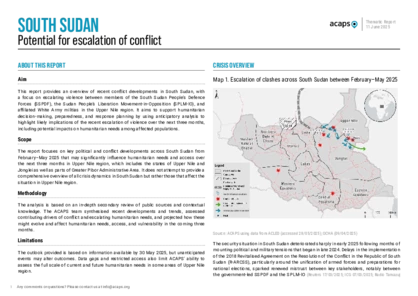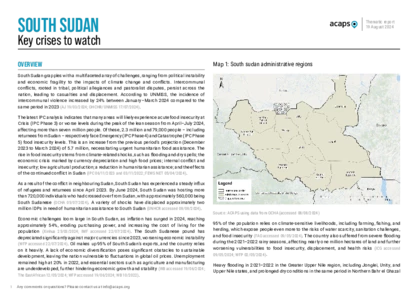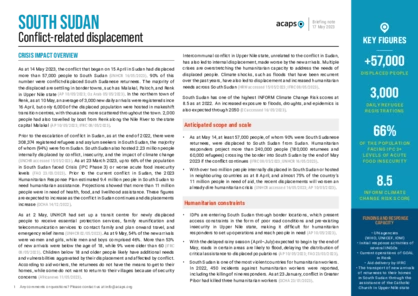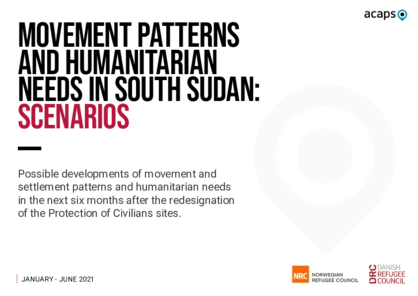Latest updates on country situation
11 November 2025
Food insecurity and malnutrition in South Sudan remain critically high, fuelled by a combination of localised conflict, widespread flooding, and recurrent displacement. Persistent insecurity continues to disrupt livelihoods, restrict humanitarian access, and undermine agricultural production. 42% of the population was projected to face high levels of acute food insecurity between September–November 2025, with 5.97 million in Crisis (IPC Phase 3) or worse levels – including 1.3 million facing Emergency (IPC Phase 4) and around 28,000 in Luakpiny/Nasir (Upper Nile) and Fangak (Jonglei) in Catastrophe (IPC Phase 5) conditions. Although this reflects a slight reduction compared to 2024, localised improvements mask severe deteriorations in conflict-affected hotspots. Violence, particularly in Upper Nile and other conflict-affected states, remains the main driver, eroding coping capacities and increasing the risk of famine in Luakpiny/Nasir under a worst-case scenario. Humanitarian access, livelihood protection, and multisectoral assistance remain critical to avert further deterioration. (IPC 04/11/2025, WVI 05/11/2025)
03 November 2025
Until 31 October 2025, floods affected over one million people across six South Sudan states, displacing 355,000. Jonglei and Unity were the hardest hit. Homes, farms, and infrastructure were destroyed, worsening food insecurity. Urgent needs include shelter items, livelihood support, and protection services for women, children, and people with disabilities. (OCHA 31/10/2025, WHO 04/11/2025, OCHA 30/10/2025)
21 October 2025
Flooding had affected more than 927,000 people across 26 counties in six states by 17 October 2025, with Jonglei and Unity states accounting for over 91% of those affected. Approximately 335,000 people have been displaced, aggravating an already critical humanitarian situation featuring food insecurity, conflict, and recurrent disease outbreaks. At least 61 schools have been damaged, disrupting education for more than 22,000 children and 700 teachers. In Unity, persistent heavy rains have again submerged the Ganyiel airstrip and damaged essential infrastructure. Access challenges and bureaucratic impediments, including more than 30 illegal checkpoints along the Nile and River Phow, which drove up transport costs between August–September, increasingly constrain humanitarian operations. Elevated fuel prices and limited market supplies hinder aid delivery, while shortages of WASH materials, shelter, and NFIs persist. Forecasts indicate above-average rainfall through December, further increasing flood risks in already vulnerable and hard-to-reach areas. (OCHA 17/10/2025, OCHA 17/10/2025, IOM accessed 21/10/2025)
15 September 2025
Since June 2025, over 9,300 South Sudanese refugees have returned from Kakuma and Kalobeyei camps in Kenya, with daily arrivals peaking at over 220 in August. The movement is prompted by food ration cuts that have left 85,000 (45% of camp populations) without assistance, triggering protests. Kakuma and Kalobeyei were hosting nearly 191,000 South Sudanese refugees. Two-thirds of the returnees are children, many arriving through Nadapal town into eastern Equatoria before moving to Budi, Ikotos, Kapoeta, and Torit towns. Families face ambush risks, lack of reception facilities, unsafe sanitation, and exposure to gender-based violence and disease at the border. While many returnees rejoin relatives, host households are increasingly overstretched, leading to overcrowding, food insecurity, and limited health and shelter access. Urgent needs include food, safe water, health services, and protection support especially for children and women, alongside assistance for host communities. (UNHCR 11/09/2025, TRT Afrika 29/08/2025, Radio Tamazuj 14/08/2025)
15 September 2025
By 11 September 2025, floods in South Sudan had affected over 311,000 people in 13 counties, with Jonglei and Unity the worst hit. More than 110,000 are displaced, farmland and infrastructure are damaged, and cholera risks are rising. Greater Pibor has declared a state of emergency, while forecasts of further heavy rains threaten worsening impacts. (OCHA 12/09/2025, UN 12/09/2025)
01 September 2025
By 27 August 2025, flooding had affected 263,000 people across Greater Pibor, Jonglei, Unity, and Upper Nile, with further impacts in Fangak, Leer, Mayom, Rubkona, and Twic East. Prolonged flood exposure is raising health risks, as stagnant water, unsafe drinking sources, and poor sanitation drive confirmed cholera outbreaks. (OCHA 29/08/2025, Eye Radio 03/09/2025, Radio Tamazuj 02/09/2025)
13 August 2025
Armed clashes on 28 July 2025 in Kajo-Keji county, Central Equatoria, between South Sudanese and Ugandan communities over a contested border have displaced more than 16,000 people into four temporary sites in Kangapo 1 and 2 payams in the county. Displaced households are sheltering in churches, schools, and makeshift structures, facing urgent needs for food, safe water, shelter, and healthcare. Overcrowding raises protection risks, particularly for women and children. Humanitarian assistance is limited as insecurity highly constrains access. Disruption to cross-border trade and livelihoods is likely to worsen already severe food insecurity levels – i.e. Crisis (IPC Phase 3) or worse – in South Sudan. Without a rapid response, humanitarian conditions could deteriorate further. The violence follows earlier July tensions involving the Uganda People’s Defence Forces and South Sudan People’s Defence Forces, highlighting the fragility of the Uganda–South Sudan border. Continued tensions may trigger additional displacement, including into Uganda. (Radio Tamazuj 06/08/2025, Xinhuanet 12/08/2025, AJ 01/08/2025)
current crises
in
South Sudan
These crises have been identified through the INFORM Severity Index, a tool for measuring and comparing the severity of humanitarian crises globally.
SSD004 - Displacement from Sudan
Last updated 27/11/2025
Drivers
International Displacement
Crisis level
Country
Severity level
3.7 High
Access constraints
5.0
SSD001 - Complex crisis
Last updated 27/11/2025
Drivers
Conflict/ Violence
Floods
Political/economic crisis
International Displacement
Crisis level
Country
Severity level
4.5 Very High
Access constraints
5.0
Analysis products
on
South Sudan
11 June 2025
South Sudan: Potential for escalation of conflict
DOCUMENT / PDF / 359 KB
This report provides an overview of recent conflict developments in South Sudan, with a focus on escalating violence between members of the South Sudan People’s Defence Forces (SSPDF), the Sudan People’s Liberation Movement-in-Opposition (SPLM-IO), and affiliated White Army militias in the Upper Nile region.
19 August 2024
South Sudan: key crises to watch
DOCUMENT / PDF / 2 MB
This report provides an overview of key humanitarian crises expected to deteriorate or see a significant humanitarian impact in the next five months in South Sudan.
Attached resources
17 May 2023
South Sudan: conflict-related displacement
DOCUMENT / PDF / 293 KB
As at 14 May 2023, the conflict that began on 15 April in Sudan had displaced more than 57,000 people to South Sudan. 90% of this number were conflict-displaced South Sudanese returnees. The majority of the displaced are settling in border towns in Upper Nile state.
27 October 2022
South Sudan: Impact of floods
DOCUMENT / PDF / 2 MB
Since August, flash and riverine floods have been severely affecting South Sudan, as is typical during the rainy season (April–November). Most of the country had below-average rainfall in June–July. The extent of flooding more than doubled between early August and early October, from 22,000km2 of South Sudan’s landmass to 48,000km2.






